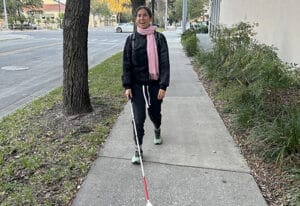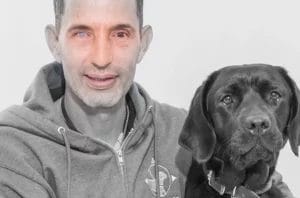Hello Everyone! My name is Cerr and I am from Colorado. I am a law student at the University of Denver, where I hope to become a disability rights lawyer. I graduated from Leader Dog with my guide Iris in February of 2019. At the time I was in my last semester of my undergraduate education, working on my degree in political science. I made the decision to apply for a guide dog because I had been accepted into a law school in a new city and I wanted to be able to feel more confident in my independence.
 Becoming a guide dog user is the best decision I have ever made, and I am so incredibly grateful to Leader Dog for matching me with such an amazing dog. She has helped me gain a level of independence I never thought I would have and has changed my life. I am excited to be able to share a little bit about my experience with my blindness and my work with disability rights (and a bunch of cute doggo photos as well).
Becoming a guide dog user is the best decision I have ever made, and I am so incredibly grateful to Leader Dog for matching me with such an amazing dog. She has helped me gain a level of independence I never thought I would have and has changed my life. I am excited to be able to share a little bit about my experience with my blindness and my work with disability rights (and a bunch of cute doggo photos as well).
I lost most of my eyesight at the end of my senior year of high school from brain damage caused by chronic exposure to methanol, which is found in paint thinner. I was an artist and had inherited a painting cabinet full of paints from my grandfather and made the mistake of putting the cabinet in my room. I had headaches for months, but I lost my sight within two weeks in the last few months of high school. Going blind later in life is an incredibly difficult transition. It forces you to have to relearn your life, and there is definitely a lot of grief.
Before I lost my sight, I didn’t know any Blind people, which made losing it that much scarier. But I think there is a huge misconception around Blindness, and Blind people, because sighted people tend not be able to see past the grief of losing sight. It makes it scary, but they can’t understand that past that, we have to keep living our lives. There isn’t really another option.
For me, it wasn’t until I met the National Federation of the Blind and found strong, passionate, high achieving, and independent blind people that I realized that the boundaries put on me were not caused by my Blindness, but by society’s perception of what it means to be a Blind person. Discovering that Blind people can in fact live the lives we want was a huge influence in pushing me past my grief and on to a career in disability rights.
One of the things that helped me most in refinding myself and my voice after losing my sight was the idea of disability not as an affliction, but as an identity. I am not successful in spite of my Blindness; I am successful with my Blindness. My Blindness is as much a part of me as anything else. By reclaiming my Blindness and accepting that it is as much a part of me and my lived experience as anything else, I was able to find pride within my Blindness. Because of this, I am a strong opponent of person first language which aims to separate a person from their disability, making it something they are separate from, instead of accepting them as whole including their disability. This is the difference between saying “I am a person who is Blind” and “I am a Blind person.” One brings pride to disability, while the other separates it from the disabled person.
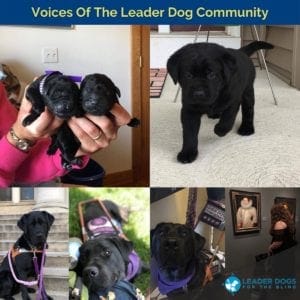 When I decided to apply for a guide dog, there were a couple of things that were really important to me. I wanted a smaller program with a longer training time and more one-on-one instruction, and an organization that focuses on positive reinforcement. Along with that, I wanted an organization that provided ownership rights after graduation. I found all of that in Leader Dog. I am so happy that I chose to apply here, and I am so grateful to have been accepted into this program. Leader Dog really does go above and beyond for their clients. During my time at Leader Dog there was a freak cold front that made it so cold we could not work outside with the dogs. Leader Dog ended up sending me home early, but they flew [Leader Dog] Iris’s instructor out with me to work in my town and the routes I was familiar with. They went above and beyond, and I could not recommend them more to anyone considering applying for a guide dog.
When I decided to apply for a guide dog, there were a couple of things that were really important to me. I wanted a smaller program with a longer training time and more one-on-one instruction, and an organization that focuses on positive reinforcement. Along with that, I wanted an organization that provided ownership rights after graduation. I found all of that in Leader Dog. I am so happy that I chose to apply here, and I am so grateful to have been accepted into this program. Leader Dog really does go above and beyond for their clients. During my time at Leader Dog there was a freak cold front that made it so cold we could not work outside with the dogs. Leader Dog ended up sending me home early, but they flew [Leader Dog] Iris’s instructor out with me to work in my town and the routes I was familiar with. They went above and beyond, and I could not recommend them more to anyone considering applying for a guide dog.
I am incredibly passionate about disability rights, which is why I decided to go to law school. I believe that most of the stigma around disability stems from a lack of understanding around disabled peoples lived experiences. Beyond the law, I believe education can help to make the biggest impact in the lives of disabled people and can help reduce the amount of the discrimination that we experience.
I believe that education is the best form of advocacy because most discrimination that Blind and disabled people face stems from a lack of education. I think a great example of this is public access issues for guide dog teams. In almost every situation where I have had an access issue, ignorance to the Americans with Disabilities Act is usually the cause. By educating businesses of the law when we have an issue, we not only make the situation better for ourselves, but we make the situation better for the next person. Some people do not like to do the emotional labor of constantly teaching when they experience discrimination. But I like to think about the motto “nothing about us, without us.” I would rather educate the sighted world of the experience of the Blind, as a Blind woman, then to have a sighted person do it instead.
A huge aspect of my advocacy is intersectionality. Intersectionality is the idea that no person is a monolith, as in, I am not just Blind or I am not just a women. I am a Blind women. I am a Blind Lesbian women. And all of these identities intersect and impact my experience with the world, which informs the way I experience my life. Advocacy that is not intersectional is not inclusive and neglects to solve real problems for real people. By acknowledging that intersectionality plays a role in the oppression of all people, and by raising up the voices of those most marginalized (BIPOC, Trans and Disabled folks), we have the ability to make the biggest most lasting positive impact.
Oppression by Kindness
In the spirit of education and advocacy, I thought I would share two infographics I made around disability and the disabled reality. Two of the most underdiscussed issues in the Blind and larger disabled communities are Oppression by Kindness and Microaggressions. I made these infographics to try and explain a little bit more about how these behaviors impact the disabled community and what able bodied people can do to help impact the oppression that disabled people experience on a daily basis.
Let’s talk disability and oppression by kindness.
What is Ableism? Power + Prejudice = Ableism
Prejudice is a preconceived judgement or opinion about a group of people without just grounds or sufficient knowledge based on a group characteristic.
Ableism is the subordinating of disabled people because of a prejudice.
What is Oppression by Kindness?
Oppression by kindness is a subcategory of Ableism.
It is the marginalization and othering of disabled people by able bodied people because of a perceived helplessness or pity for the disabled person, not out of respect for the individual as a person.
What is Pity?
Pity is the feeling of sorrow and compassion caused by the suffering and misfortunes of others.
How does this Differ from Perceived Oppression?
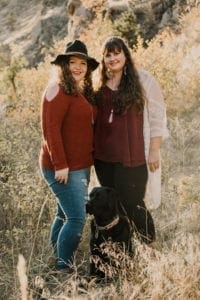
It differs because perceived oppression does not exist. There are many types of oppression. Internalized oppression is one of them. Even when an individual has internalized oppression (also known as internalized ableism) it is caused by an outward reinforcement that the person is lesser. This is a symptom of continuous recurring discrimination and oppression, not a fault of the individual.
People can have perceived privilege, by believing they are better than others when in fact they aren’t. However, oppressed people do not “perceive” that they are oppressed. There are innumerable ways in which oppression shows up, and if you feel that you are in a place of power enough to invalidate someone else’s experience, your opinion on the matter is likely inaccurate and unwanted.
What are Some Examples of Oppression by Kindness?
Using disabled people to raise funding (like the telethons of the 80s and the “advocacy” of Foundation Fighting Blindness).
Adopting disabled children because of their disabilities.
Helping a disabled person without asking them first.
Programs designed to “help” disabled people do recreational things.
Speaking for disabled people because you “think” you know what they want.
Separating a service dog from their handler during a medical episode.
But I’m Being Kind, What’s the Big Deal?
Individually, these things seem harmless. “The kids are getting adopted, aren’t they?” “They are trying to cure blindness.”
The issue is that these programs (made by able bodied people) are at their core based on an ableist notion that disabled people need able bodied help. This reinforces the idea that disabled people are a pitiful group that without abled bodied people’s kindness and support cannot succeed in the world. It also puts the disabled person in a situation where if they voice their dislike or unhappiness with the decisions being made, they are considered ungrateful or rude. This controls the ability of disabled people to be able to interact with the word in a self-affirming and independent way.
But If We Aren’t Helping These Disabled People, They Will Never Get to Do These Things!
There is a difference between helping a disabled person reach their full potential through support, and needed or wanted caretaking and assuming a disabled persons needs without their consent. It is the difference between: Organizations FOR the blind and organizations OF the blind, Autism Speaks and the Autism Self Advocacy Network, The Breckenridge Outdoor Exploration Program and No Barriers USA.
One supports the disabled persons right to decide/human autonomy and the other assumes what disabled people need or want.
So, What’s the Solution?
Part of the contention around Oppression by Kindness, is that for a significant amount of time, disability culture has been dictated through parents and caretakers of disabled people, not from disabled people themselves. The Oppression by Kindness model doesn’t say don’t help disabled people, it says help them help themselves.
Ask first.
Consider to yourself, am I doing this for this person to make this person more autonomous as a person, or am I doing it to make myself feel like I am doing good?
It’s all about thinking about what the disabled person wants and is asking for and giving them the space to have a voice while respecting their human autonomy as a person.
Well, This is Just Your Opinion; I Don’t Feel Oppressed.
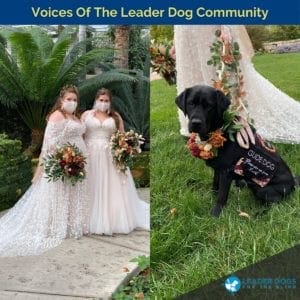 Oppression is multifaceted and, in some situations, incredibly subtle. What is oppressing a group can seem totally fine to individuals in the moment. However, that doesn’t make it fine, and it doesn’t mean disabled people should just sit by and watch it happen. In order to make change its about having the conversation. Autonomy and human dignity are important in disabled people’s existence in the world. As a community we are still incredibly recently deinstitutionalized, with many people still being institutionalized and controlled because of their disability. By reinforcing stereotypes around disabled people being pitiful, helpless creatures, we make it more difficult for our community to fully integrate and live the lives we want independently, autonomously and publicly.
Oppression is multifaceted and, in some situations, incredibly subtle. What is oppressing a group can seem totally fine to individuals in the moment. However, that doesn’t make it fine, and it doesn’t mean disabled people should just sit by and watch it happen. In order to make change its about having the conversation. Autonomy and human dignity are important in disabled people’s existence in the world. As a community we are still incredibly recently deinstitutionalized, with many people still being institutionalized and controlled because of their disability. By reinforcing stereotypes around disabled people being pitiful, helpless creatures, we make it more difficult for our community to fully integrate and live the lives we want independently, autonomously and publicly.
If you don’t feel oppressed by these types of situations or have never run into them, you are incredibly lucky. This is not an excuse to discredit other disabled people’s lived experiences or to attack others.
Please remember to be kind on the internet. We are all people here.
Let’s Talk Service Dogs and Microaggressions
What Are Microaggressions?
These are brief verbal, behavioral or environmental indignities, both intentional and unintentional, that communicate hostile, derogatory or negative prejudicial slights and insults toward any group, particularly marginalized groups.
How do Microaggressions Show Up for Service Dog Handlers?
It looks like: acknowledging the dog before the person, talking directly to the dog, asking the person what is wrong with them or discrediting their need for the dog because they do not “look” disabled, questioning the person’s need for the dog, commenting on the behavior or looks of the dog
“Does that dog ever get to play?”
“What a sad life for a dog.”
“You need to give that dog water.”
“Oh he just wants to be a pet doesn’t he.”
“I know I’m not supposed to pet, but your dog is sooo cute.”
“Oh my God I wish I could bring my dog places with me.”
“Your dog is just too cute!”
“You are just so cute aren’t you! Yes you are!”
But Like, I Was Just Trying to be Nice. So What’s the Issue?
The issue is that service dogs are not a fun thing. They aren’t a fashion statement like a purse or a cute shirt. They aren’t something that a disabled person can just take off and put to the side. They are an everyday, 24-hour tool to help that person get as close to “normal” as they can. A service dog handler doesn’t get to take off the “identity of being a service dog handler” often if at all.
It comes down to understanding the world of a disabled person, and what kind of interactions exist because of their disability.
For example, as a visually impaired handler, I have two options to travel safely by myself. Cane or dog. Canes are bulky, difficult to use in bad weather and require more constant effort than a dog. With my dog, I am able to travel alone quickly and efficiently.
When a handler is with a dog, the interactions they have with the public are incredibly limited. The dog does a couple of things.
- It “outs” that person as having a disability if it wasn’t apparent before.
- It “others” that person, meaning there is an instant stigma attached to their identity.
- It creates a dichotomy where people want to interact with the dog, but are also uncomfortable with the person.
In order to combat this, most people revert to comments that at face value look like compliments. However, consider how many times in a day/week/month that person has had the same conversation. It’s not even really a conversation. It’s a statement about that person, to which the person is forced to respond. If they snap they risk being called rude, forcing the individual to hide their feelings about the subject in order to make the able-bodied people around them more comfortable. It makes that person do emotional labor, and the forcing of labor is a type of oppression.
If you feel as though you can’t just leave the handler be, here are some things that you could comment on instead of the dog, or the handlers lack of apparent disability.
“Wow, your gear is really fantastic. Its beautiful.”
“Your outfit/shirt/makeup is great!”
“I like your style.”
“Do you know where X place is.”
Honestly, just anything but the dog. We are so tired of hearing about the dog. Give us something else to talk about.
Thank you so much for allowing me to share a bit of my story with you all. I love talking about my experience and sharing cute pictures of Iris (isn’t she the cutest?). If you are interested in following along on our little life adventure, you can follow Iris and I at @blindhippiedog or @theblindhippie, where I share about my life with a guide dog and the occasional educational infographic.
If you are considering a guide dog, or know someone who is, I would definitely recommend looking into Leader Dogs for the Blind and seeing if they would be a good fit. I really could not recommend them more.
Read more about our Voices of the LDB Community initiative.

